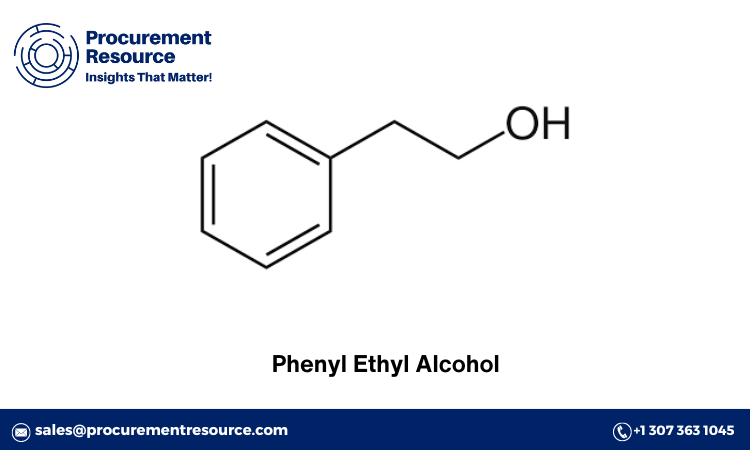Phenyl ethyl alcohol (PEA), a versatile aromatic compound with a pleasant floral odor, is widely utilized in the fragrance, flavor, and pharmaceutical industries. This organic compound, known for its distinct rose-like scent, is a key ingredient in perfumes, soaps, cosmetics, and various flavoring agents. Additionally, it serves as a preservative in pharmaceutical formulations, contributing to its broad market demand. Understanding the price trend of phenyl ethyl alcohol is crucial for stakeholders in these industries to make informed decisions regarding production, procurement, and market strategies.
The phenyl ethyl alcohol market has been subject to various influences, ranging from raw material availability and production costs to demand fluctuations in end-use sectors. In this report, we delve into the recent trends, forecasts, and market analysis to provide a comprehensive overview of the phenyl ethyl alcohol price trajectory.
Phenyl Ethyl Alcohol Price Trend
The price of phenyl ethyl alcohol has experienced significant fluctuations over the past few years. Several factors contribute to these variations, including changes in crude oil prices, which impact the cost of petrochemical derivatives used in PEA production, and shifts in demand from the fragrance and flavor industries.
Request For Sample: https://www.procurementresource.com/resource-center/phenyl-ethyl-alcohol-price-trends/pricerequest
In recent years, the price trend has shown an upward trajectory, driven by increased demand in the fragrance and cosmetics sectors. The rising popularity of natural and organic products has further fueled the demand for phenyl ethyl alcohol, as it is often used in natural formulations. Moreover, the COVID-19 pandemic initially caused disruptions in the supply chain, leading to temporary price hikes. However, as the market stabilized, prices began to normalize, albeit at a higher base compared to pre-pandemic levels.
The phenyl ethyl alcohol price trend also exhibits seasonal variations, with higher prices typically observed during peak production periods for fragrances and flavors, such as the spring and summer months when demand for floral scents increases. Additionally, regulatory changes and environmental considerations related to the production processes can influence the price dynamics of phenyl ethyl alcohol.
Forecast Report
Looking ahead, the phenyl ethyl alcohol market is expected to continue its growth trajectory, driven by sustained demand from the fragrance, flavor, and pharmaceutical industries. According to market forecasts, the global phenyl ethyl alcohol market is anticipated to grow at a compound annual growth rate (CAGR) of approximately 5% over the next five years.
Several factors underpin this positive outlook. Firstly, the increasing consumer preference for natural and organic products is expected to boost the demand for phenyl ethyl alcohol. As consumers become more conscious of the ingredients in their personal care and cosmetic products, the demand for naturally derived compounds like PEA is likely to rise.
Secondly, the expanding middle-class population in emerging economies is expected to drive the demand for premium fragrances and cosmetics, further supporting the growth of the phenyl ethyl alcohol market. Additionally, the pharmaceutical industry’s ongoing research and development activities to enhance preservative formulations are likely to contribute to the steady demand for PEA.
However, certain challenges may temper the growth prospects. Fluctuations in crude oil prices, environmental regulations, and supply chain disruptions could impact the production costs and availability of phenyl ethyl alcohol, influencing its market dynamics. Therefore, stakeholders must stay vigilant and adapt to these potential challenges to capitalize on the growth opportunities in the market.
Market Analysis
The phenyl ethyl alcohol market is characterized by a diverse range of applications, making it an integral component in multiple industries. This market analysis provides insights into the key drivers, restraints, opportunities, and competitive landscape influencing the phenyl ethyl alcohol market.
Key Drivers
- Rising Demand in the Fragrance Industry: The global fragrance industry is a major consumer of phenyl ethyl alcohol, utilizing it as a primary ingredient in perfumes and colognes. The increasing consumer preference for high-quality and long-lasting fragrances drives the demand for PEA.
- Growth in the Cosmetic Sector: Phenyl ethyl alcohol is widely used in cosmetics and personal care products due to its antimicrobial properties and pleasant aroma. The growing beauty and personal care market, particularly in emerging economies, is a significant driver for PEA demand.
- Pharmaceutical Applications: In the pharmaceutical industry, PEA is used as a preservative in various formulations, including injectable drugs and topical applications. The expanding pharmaceutical sector, coupled with the need for effective preservatives, supports the demand for phenyl ethyl alcohol.
Key Restraints
- Raw Material Price Volatility: The price of phenyl ethyl alcohol is influenced by the cost of raw materials, particularly petrochemical derivatives. Fluctuations in crude oil prices can impact the production costs and, consequently, the market price of PEA.
- Environmental Regulations: Stringent environmental regulations related to the production and disposal of chemical compounds pose challenges for manufacturers. Compliance with these regulations may increase production costs and affect the overall market dynamics.
Opportunities
- Natural and Organic Product Trends: The growing trend towards natural and organic products presents significant opportunities for phenyl ethyl alcohol manufacturers. Developing sustainable and eco-friendly production processes can attract environmentally conscious consumers and expand market reach.
- Emerging Markets: The rising disposable incomes and changing lifestyles in emerging markets, such as Asia-Pacific and Latin America, offer lucrative growth opportunities for the phenyl ethyl alcohol market. Manufacturers can tap into these markets by introducing innovative products tailored to local preferences.
Competitive Landscape
The phenyl ethyl alcohol market is highly competitive, with several key players operating globally. Some of the prominent companies in the market include BASF SE, Symrise AG, Sigma-Aldrich (Merck KGaA), TCI Chemicals, and Alfa Aesar. These companies focus on strategic initiatives such as mergers and acquisitions, product innovations, and collaborations to strengthen their market position and expand their product portfolios.
Latest News
Staying updated with the latest news and developments in the phenyl ethyl alcohol market is essential for stakeholders to make informed decisions. Here are some recent highlights:
- Innovation in Sustainable Production: Leading manufacturers are investing in research and development to develop sustainable and eco-friendly production methods for phenyl ethyl alcohol. This includes exploring renewable raw materials and green chemistry processes to reduce environmental impact.
- Market Expansion Initiatives: Companies are expanding their production capacities and distribution networks to meet the growing demand for phenyl ethyl alcohol. For instance, BASF SE recently announced the expansion of its production facility in Germany to enhance its supply capabilities.
- Regulatory Developments: Regulatory agencies are continuously updating guidelines and standards for the use of phenyl ethyl alcohol in various applications. Staying compliant with these regulations is crucial for manufacturers to ensure product safety and market acceptance.
- Collaborations and Partnerships: Industry players are forming strategic partnerships to leverage each other’s strengths and enhance their market presence. Collaborative efforts between fragrance houses and raw material suppliers are common to develop innovative and high-quality products.
In conclusion, the phenyl ethyl alcohol market is poised for growth, driven by rising demand in key end-use industries and favorable market trends. However, stakeholders must navigate challenges such as raw material price volatility and regulatory constraints to capitalize on the opportunities in this dynamic market. By staying informed about the latest trends and developments, businesses can make strategic decisions to thrive in the phenyl ethyl alcohol market.









